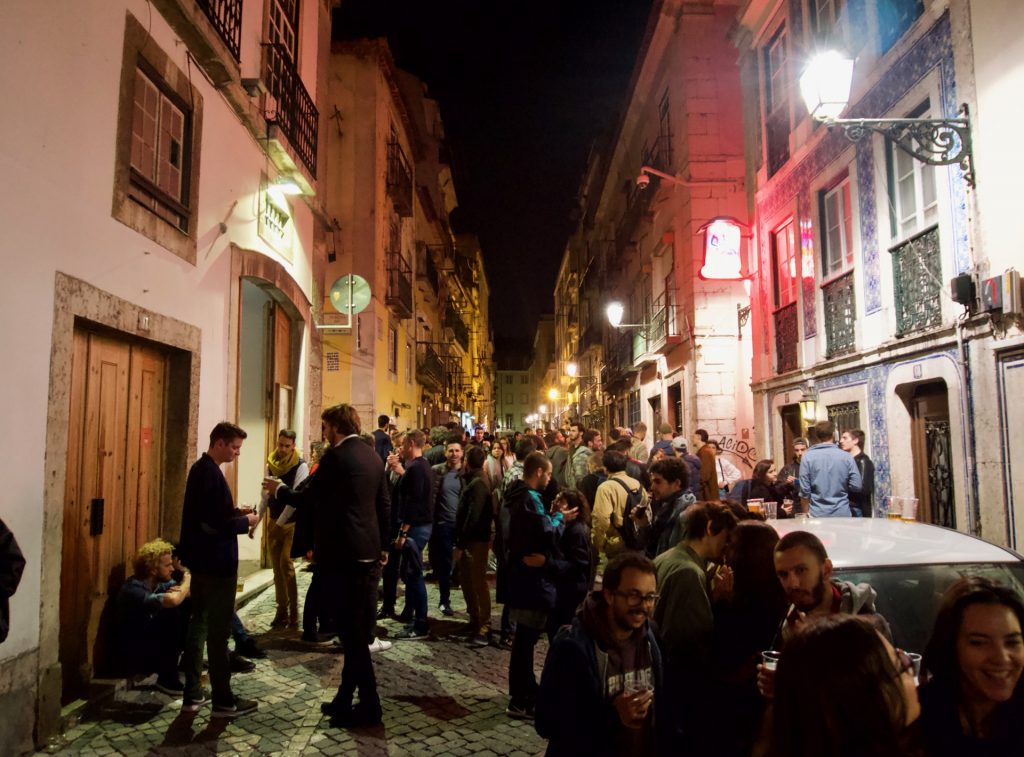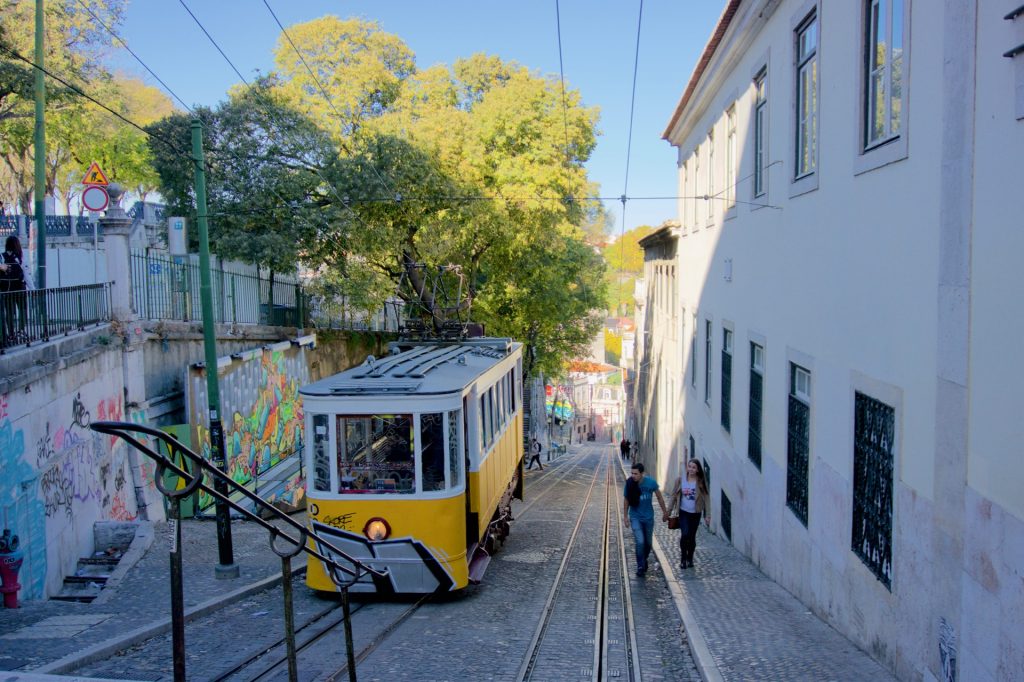November may not seem like the best time to visit Lisbon, but if you’re from a cold, northern country then you’ll be in for a pleasant surprise. In the middle of November you can expect the daytime temperature to hover around 20-25 degrees centigrade, plus the bulk of the crowds will have thinned out from their peaks in June to September, so you’ll have the city (almost) to yourself! So, what can you get up to in the city of seven hills? Here’s five of the best things to do in Lisbon in November!
Drink in Bairro Alto
Bairro is Portugese for district, while alto means high, so unsurprisingly, you’ll find that Bairro Alto is situated on one of Lisbon’s many hills, so you’ll find a lot of steep inclines.
But hill walking is not the attraction of this popular area of the Portuguese capital – it’s the nightlife. Nestled within the labyrinth of narrow streets and old buildings are 200 tiny bars. While some will have one or two rooms inside, often in the basements or ground floors of buildings, many will be absolutely tiny, with room only for a bar, and maybe just a handful of seats or a small standing area.

With no real inside space, the only thing to do is to head outside, where you’ll find the streets packed with people. The whole neighbourhood is basically one giant bar, which starts to fill out about 11 and goes on until 2, when the bars close and those left head down to the clubs at the “pink street”.
So what should you drink while in Bairro Alto? One of the local favourites is a Caipirinha, which is in fact not Portuguese, rather the national cocktail of Brazil, made from Cachaça, limes, sugar and plenty of ice.

You’ll find that most places serve these drinks in different sizes: medium, large, extra large, and the monstrous XXL – served in giant 750ml cups, for about €6.50-8. Be careful, because these drinks are potent!
Finally, how to pronounce Caipirinha: Kai-pee-reen-yah.
Ride the vintage trams
Lisbon is famous for it’s vintage trams, which used to cover much of the city at their peak in the late 1950s, but where largely cut back in more recent years. Today, only a few lines survive, including the E28 – the classic tram which offers a great tour of the city.
This route still uses vintage trams dating back to the 1930s, necessary because modern trams could not navigate the steep hills and narrow turns on the route. As a result, these old trams were upgraded with new engines and brakes in the 1990s, rather than design new vehicles.

Many tourist sites recommend getting on at Martim Moniz and riding the whole route, but we found that the queues were HUGE by about 10am, even in the comparative quite of November. Instead, it was easy to hop on at an intermediate stop on the tram’s way back from the castle, and pretty much from any stop in the evening when there are less tourists. Just be aware that you’ll be booted off at the end of the line, presumably to stop people riding around the system continuously.
Taking a ride is well worth it and like stepping back in time. You’ll be amazed at some of the tiny gaps that these trams are able to get through, especially between the old buildings on the hills surrounding the castle!
Another popular attraction are the three funicular railways: Gloria, Bica and Lavra, again using archaic vehicles. These trams take you up some of the steepest inclines in the city.

The cheapest way to travel is to pick up a 24-hour ticket for €6.15, valid on any of the yellow trams and all the funiculars. These can only be bought from metro stations, so don’t hop on the tram unless you’re willing to pay €2.80 for a single ticket.
Finally, if you head further afield, you’ll also find old tram tracks seemingly going nowhere. These are the remnants of the older, larger network of tram routes that was cut back and replaced with bus routes, but never removed. Perhaps one day the trams will return?
Visit the Alfama District
The Alfama district is the oldest in Lisbon, on the hills between the São Jorge Castle and the Tejo river, reachable on the E28 tram. It’s the only district to have survived the earthquake of 1755, and so the tiny lanes stand as they did in medieval times.

You’ll find remains of medieval buildings from the north African Moors, who had settled in the area before the Reconquista, and even buildings dating back to the Romans. As you explore, you’ll get lost in a labyrinth of tiny passage ways and hidden stairs. But while it can seem like a bit of a maze, just remember, if you ever get lost in Lisbon, walk down hill and you’ll soon come to the river!

Alongside the architecture, the way of life in this neighbourhood hasn’t changed in years. All the residents seem to know everyone, with many generations of locals hanging out together like a huge family. It’s hard to believe this quiet district is in the centre of one of Europe’s capitals!
A great way to learn about Alfama is on a free walking tour – I took the free Lisbon Chill Out tour and got a chance to learn much more about the district than I ever could alone, as well as a tour that took us across the most interesting parts of Lisbon!
São Jorge Castle
Towering above Alfama on one of Lisbon’s seven hills is the São Jorge Castle, a Moorish castle dating back to the 10th century and captured by Christian forces during the Recinquista in 1147. According to the legend, the knight Martim Moniz led an attack on one of the castle gates, and upon seeing that a door was open, he threw himself into it to wedge it open and allow his soldiers through at the cost of his life. You can find it today – named Porta de Martim Moniz (Gate of Martim Moniz) in his honour.

Starting at Praça Martim Moniz – also named after the hero – at the foot of the castle, you can climb up to the the castle above through a myriad of cobbled streets and staircases. It’s a tough climb, but well worth it for the view over the city alone!
Unlike in 1147, getting into the castle grounds is much cheaper (it won’t cost you your life!), costing €8.50 for adults and €5 for students.
Once inside the castle there’s plenty to explore, but if you’d rather have a rest and a drink after the climb, there’s a wine bar in the castle with seating overlooking the city. Make sure you have your camera at the ready because the views are spectacular!

Once you’ve seen enough, it’s easy to hop on the tram to get back to the city centre, as most people tend to get off at the castle.
If you have time, it’s also worth coming back at night for a spectacular view across the city!

Have you been to Lisbon? Wha’s your no. 1 tip for getting the most out of the city? Let us know in the comments!

